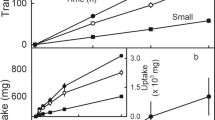Abstract
THERE have been attempts to determine potential biological yield on the basis of the size and efficiency of the photosynthetic apparatus. Economic yield, however, depends on the successful partition of assimilates to useful parts of the plant and, in the case of fruit crops, to the reproductive organs1,2. In the strawberry, one component of yield is fruit size, which we have shown to be determined by the number of fertilized ovules (achenes) on the surface and the degree of receptacle expansion associated with each achene. Berry weight is highly correlated with achene spacing and achene number, so that for each value of achene spacing there is a linear relation between berry weight and achene number (Table 1).
This is a preview of subscription content, access via your institution
Access options
Subscribe to this journal
Receive 51 print issues and online access
$199.00 per year
only $3.90 per issue
Buy this article
- Purchase on Springer Link
- Instant access to full article PDF
Prices may be subject to local taxes which are calculated during checkout
Similar content being viewed by others
References
Nichiporovich, A. A., and Strogonova, L. E., Agrochimica, 2, 26 (1957).
Bleasdale, J. K. A., Ann. Appl. Biol., 57, 173 (1966).
Abbott, A. J., Best, G. R., and Webb, R. A., J. Hort. Sci. (in the press).
Author information
Authors and Affiliations
Rights and permissions
About this article
Cite this article
ABBOTT, A., WEBB, R. Achene Spacing of Strawberries as an Aid to calculating Potential Yield. Nature 225, 663–664 (1970). https://doi.org/10.1038/225663b0
Received:
Issue Date:
DOI: https://doi.org/10.1038/225663b0
Comments
By submitting a comment you agree to abide by our Terms and Community Guidelines. If you find something abusive or that does not comply with our terms or guidelines please flag it as inappropriate.



